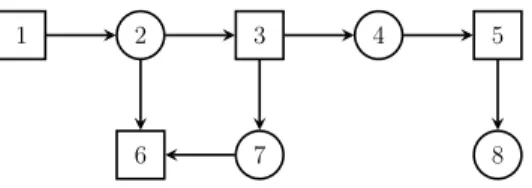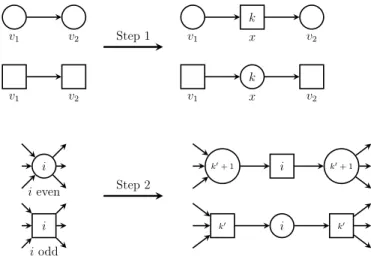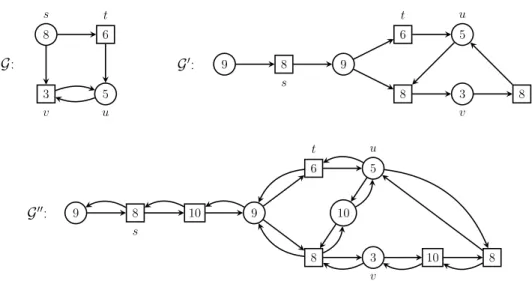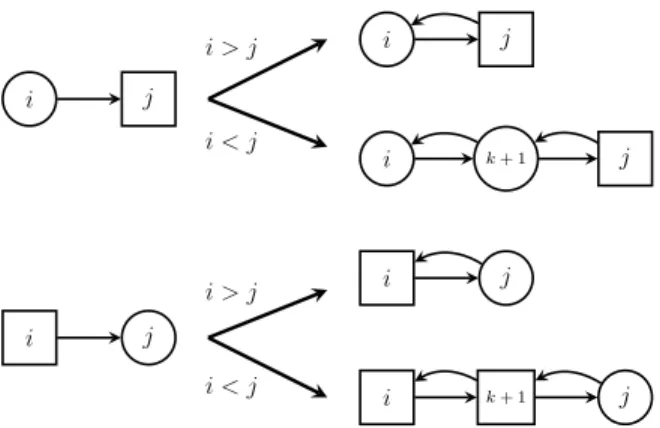HAL Id: hal-01260646
https://hal.inria.fr/hal-01260646
Submitted on 22 Jan 2016HAL is a multi-disciplinary open access archive for the deposit and dissemination of sci-entific research documents, whether they are pub-lished or not. The documents may come from teaching and research institutions in France or abroad, or from public or private research centers.
L’archive ouverte pluridisciplinaire HAL, est destinée au dépôt et à la diffusion de documents scientifiques de niveau recherche, publiés ou non, émanant des établissements d’enseignement et de recherche français ou étrangers, des laboratoires publics ou privés.
Parity Games on Undirected Graphs
Dietmar Berwanger, Olivier Serre
To cite this version:
Dietmar Berwanger, Olivier Serre. Parity Games on Undirected Graphs. Information Processing Letters, Elsevier, 2012, 112 (23), pp.5. �10.1016/j.ipl.2012.08.021�. �hal-01260646�
Parity Games on Undirected Graphs
Dietmar Berwangera, Olivier Serreb
aLSV, ´Ecole Normale Sup´erieure de Cachan & CNRS, France bLIAFA, Universit´e Paris Diderot – Paris 7 & CNRS, France
Abstract
We examine the complexity of solving parity games in the special case when the underlying game graph is undirected. For strictly alternating games, that is, when the game graph is bipartite between the nodes of the two players, we observe that the solution can be computed in linear time. In contrast, when the assumption of strict alternation is dropped, we show that the problem is as hard in the undirected case as it is in the general, directed, case.
Keywords: parity games, graph structure complexity
1. Introduction
Parity games are path-forming games on directed graphs with important applications to automata theory, logic, and verification. Notably, the problem of determining the winner of a parity game on a finite graph is polynomial-time equivalent to checking whether a µ-calculus formula holds in a finite model [3, 4].
The computational complexity of solving parity games is subject to an intriguing open question. The known upper bound is NP ∩ Co-NP, but it is unknown whether the problem can be solved in polynomial time; the currently best deterministic algorithm runs in time nO(
√ n) [7].
The problem received considerable attention over the last decade, and specialised algorithms were proposed for subclasses where certain structural parameters of the game graph are restricted. At the outset, Obdrˇz´alek [8] ex-hibited a polynomial-time algorithm for parity games on graphs of bounded tree-width. Yet, as he points out, tree-width measures the connectivity of the undirected graphs underlying the directed game graph, and the algorithm would not give good bounds, for instance, on directed acyclic graphs, even though solving the games on such graphs is easy. In line with the intuition
that the complexity of parity games is sensitive to the direction of edges, sev-eral studies focused henceforth on connectivity measures designed for directed graphs. Thus, it was shown that parity games can be solved in polynomial time on directed graphs of bounded entanglement [2], dag-width [1], clique-width[9], or Kelly-width [6].
In this note, we argue that the directedness of the game graph may not be the main responsible for the computational complexity of parity games, and show that hard instances can already be found among games on undirected graphs, i.e., graphs where each edge comes with a back-edge. In support of the prevalent belief that games on undirected graphs are simple, we present a linear-time algorithm for the case where the two players strictly alternate their moves, that is, where the graph is bipartite between the nodes of the two players. However, for the case where this assumption is dropped, we show the following, somehow surprising, result: Solving parity games on undirected graphs is polynomial-time equivalent to solving parity games on arbitrary, directed graphs.
2. Parity games
A finite graph is a pair G = (V, E) where V is a finite set of vertices and E ⊆ V × V is an edge relation. We say that the graph is undirected, if the edge relation E is symmetric, that is, (v1, v2) ∈ E if, and only if, (v2, v1) ∈ E,
for all v1, v2 ∈ V . A dead-end is a vertex v such that there is no vertex v0 with
(v, v0) ∈ E. A path is a finite sequence v1, v2, . . . , v` such that (vi, vi+1) ∈ E
for every 1 ≤ i < `; a cycle is a path v1, v2, . . . , v` with ` > 1 and v1 = v`.
A graph that does not have any cycle is acyclic. The size of a graph is the number |V | of its edges plus the number |E| of its edges.
A parity game is a game for two players, we call them ´Elo¨ıse and Abelard, described by a tuple G = (V, E, VE, VA, Ω) where G = (V, E) is a finite graph,
V = VE] VA is a partition of the vertex set into positions VE of ´Elo¨ıse and
VA of Abelard, and Ω : V → N is a priority function. We say that the game
is bipartite if E ⊆ VE×VA∪VA×VE. An example of a parity game is depicted
in Figure 1: circles and squares represent vertices of VE and VA, respectively,
and the label indicates the priority.
To play a game G, the two players move a token along the edges of the game graph. Starting from a designated initial vertex v0, a play proceeds as
follows: if v0 ∈ VE then ´Elo¨ıse moves to a vertex v1 such that (v0, v1) ∈ E;
if v0 ∈ VA, Abelard does the move. Then, the player who owns v1 chooses
1 2 3 4 5
6 7 8
Figure 1: A bipartite parity game on an undirected graph.
a successor v2 and so on. If, at some point, the player in turn cannot move,
she or he loses the play. Otherwise, the play yields an infinite sequence v0v1v2· · · ∈ Vω, and the winner is determined by looking at the least priority
seen infinitely often along this sequence: ´Elo¨ıse wins, if lim inf(Ω(vi))i≥0 is
even, otherwise Abelard wins. A partial play is a prefix of a play.
A strategy for ´Elo¨ıse is a function σ assigning, to every partial play that ends in a vertex v ∈ VE, a vertex v0 such that (v, v0) ∈ E. A play π =
v0v1v2. . . follows the strategy σ if vi+1 = σ(v0. . . vi), for all i ≥ 0 with
vi ∈ VE. A strategy σ for ´Elo¨ıse is winning from a position v ∈ V if she
wins every play that starts from v and follows σ. In this case, we also say that the vertex v ∈ V is winning for ´Elo¨ıse; the winning region of ´Elo¨ıse consists of all her winning vertices. The corresponding notions for Abelard are defined analogously. For example, in the parity game in Figure 1, the winning region for ´Elo¨ıse is {1, 2, 6, 7} and the one for Abelard is {3, 4, 5, 8} (here, we identify vertices with their priority).
Of special interest are strategies that depend only on the current vertex. A strategy σ is positional if, for every partial play π and every vertex v, we have σ(π · v) = σ(π0· v). In that case, the strategy can be represented as a function σ : V → V . A crucial property of parity games is that positional winning strategies always exist.
Theorem 1 (Positional determinacy [5]). For any vertex of a parity game, either ´Elo¨ıse or Abelard has a positional winning strategy.
3. Solving bipartite games on undirected graphs is easy
For this section, let us fix an undirected graph G = (V, E), underlying a bipartite game G = (V, E, VE, VA, Ω). We show that the winning regions in
Towards this, we consider the directed graph G0 = (V, E0) obtained from G by removing one of any two opposite edges (i, j), (j, i) ∈ E as follows:
E0 := {(i, j) ∈ E : i ∈ VE and min{Ω(i), Ω(j)} even, or
i ∈ VA and min{Ω(i), Ω(j)} odd }.
Let G0 = (V, E0, VE, VA, Ω) be the parity game on the obtained orientation G0
of G, with VE, VA, and Ω as in G. (For an example, see Figure 2.) We argue
that this transformation does not change the winning regions of the game. Intuitively, this is because the removed edges would not be profitable to a player using a positional strategy.
1 2 3 4 5
6 7 8
Figure 2: Orientation of the game in Figure 1.
Lemma 1. A vertex v ∈ V is winning for ´Elo¨ıse in G if, and only if, v is winning for ´Elo¨ıse in G0.
Proof. Let σ : V → V be a positional strategy for ´Elo¨ıse in G that is winning from v0, and let σ0 be a positional strategy in G0 that agrees with σ on any
vertex v ∈ V with (v, σ(v)) ∈ E0. We claim that σ and σ0 agree along any play from v0 in G. Concretely, for every partial play v0v1. . . vi in G that
follows σ to a vertex vi ∈ VE, the prescribed prolongation vi+1 = σ(vi) is
along an edge (vi, vi+1) that belongs to E0. This is because v0· · · (vi· vi+1)ω is
an infinite play in G that follows the winning strategy σ, hence the smallest priority min(Ω(vi), Ω(vi+1)) seen infinitely often must be even, implying that
the edge (vi, vi+1) is maintained in E0. Consequently, every play from v0 that
follows σ0 in G0 corresponds to a play in G that follows σ and is thus winning for ´Elo¨ıse. The same reasoning applies for positions in the winning region of Abelard.
It turns out that the transformed game G0 has a very simple structure.
Lemma 2. The game graph of G0 is acyclic.
Proof. Towards a contradiction, assume that G0contains a cycle v1, v2, . . . , v`.
Let us pick i such that Ω(vi) is minimal; since the length ` must be even and
greater than two, we can assume without loss that 1 < i < `. Suppose that vi ∈ VE. As (vi−1, vi) ∈ E0, it follows that Ω(vi) = min(Ω(vi−1), Ω(vi))
must be odd. On the other hand, as (vi, vi+1) ∈ E0, it follows that Ω(vi) =
min(Ω(vi), Ω(vi+1)) must be even: a contradiction. The argument for the
case when vi ∈ VA is analogous.
Parity games over acyclic graphs admit only finite plays: a player wins if, and only if, he can ensure that every play reaches a dead-end belonging to the other player. Thus, we have a so-called reachability game, for which it is well known that winning regions can be computed in linear time in the size of the underlying graph (see, e.g., [4]). Together with the equivalence in Lemma 1, this implies the following.
Proposition 1. For any bipartite parity game on an undirected graph, the winning regions can be computed in linear time in the size of the graph. 4. Games on arbitrary, undirected graphs can be hard
In this section, we show that restricting parity games to undirected graphs does not make them computationally simpler. Towards this, we give a polynomial-time reduction for the problem of computing the winning regions in parity games on arbitrary directed graphs to the corresponding problem on general, not necessarily bipartite, undirected graphs.
For the following, let us fix be a parity game G = (V, E, VE, VA, Ω) on an
arbitrary, directed graph G = (V, E). The idea is to encode the directions of edges in E in an undirected graph. Towards this, we first bring G into a normalised form (see Figure 4 for an example).
Lemma 3. There exists a game G0 = (V0, E0, VE0, VA0, Ω), with V ⊆ V0 such that a vertex v ∈ V is winning for ´Elo¨ıse in G if, and only of, v is winning for ´Elo¨ıse in G0, which satisfies the following properties:
(1) G0 is bipartite;
(2) for every v0 ∈ V0, the priority Ω(v0) is odd if, and only if v0 ∈ V0 E, and
Proof. To ensure properties (1) and (2), we describe a simple transformation of the game graph in two steps, illustrated in Figure 3.
(Step 1) Towards turning G into a bipartite game, we insert dummy vertices with an insignificant priority. Let k be the highest priority in the range of Ω. For every edge (v1, v2) ∈ E with v1, v2 ∈ VE, we add a fresh
vertex x ∈ VA of priority k, and replace the edge (v1, v2) by the two edges
(v1, x) and (x, v2). For edges (v1, v2) ∈ E with v1, v2 ∈ VA we proceed in the
dual way (i.e. we let x ∈ VE).
(Step 2) To ensure that all vertices of odd priority belong to ´Elo¨ıse and those of even priority to Abelard, we proceed as follows. Let k0 be the least even number greater than any priority in the range of Ω. For any vertex v ∈ VE of even priority, let v belong to VA0 and add two vertices vin and vout
to VE0, both of priority k0+ 1. Then, add two edges (vin, v) and (v, vout), and
replace any incoming edge (x, v) ∈ E with an edge (x, vin) ∈ E0 and any
outgoing edge (v, x) with an edge (vout, x) ∈ E0. For the vertices v ∈ VA
of odd priority, we perform the dual transformation. All other vertices and edges remain unchanged.
Clearly, the size of the resulting game graph G0 = (V0, E0) is linear in the size of G. It is an easy exercise to verify that the transformations preserve the membership of any position v ∈ V in the winning region of ´Elo¨ıse or Abelard. v1 v2 v1 k x v2 v1 v2 v1 k x v2 Step 1 i i even k0+ 1 i k0+ 1 Step 2 i i odd k0 i k0
Figure 3: Normalisation rules (Lemma 3).
8 s 6 t 3 v 5 u G: G0: 9 8 s 9 6 t 8 3 v 8 5 u G00: 9 8 s 10 9 6 t 8 3 v 10 8 5 u 10
Figure 4: Normalisation (G0) and direction encoding (G00) for the game G.
According to Lemma 3, we can assume without loss that the game G is bipartite, with vertices of odd priority belonging to VE and those of even
priority to VA.
Next, we transform G into a game G0 = (V0, E0, VE0, VA0, Ω0) on an undi-rected game graph G0 = (V0, E0) with V0 ⊇ V and prove that this transfor-mation preserves the winning regions.
Let k be the maximal colour appearing in G. The graph G0 is obtained from G as follows (see Figure 5).
• For every (v1, v2) ∈ E ∩ VE× VA, let i = Ω(v1) and j = Ω(v2). If i > j,
simply add the back-edge (v2, v1). If i < j, create a new vertex x ∈ VE0
of priority k + 1, remove the edge (v1, v2), and add edges (v1, x) and
(x, v2) together with their back-edges (x, v1) and (v2, x).
• For every (v1, v2) ∈ E ∩ VA× VE , let i = Ω(v1) and j = Ω(v2). If i > j,
simply add the back-edge (v2, v1). If i < j, create a new vertex x ∈ VA0
of priority k + 1, remove edge (v1, v2) and add the edges (v1, x) and
(x, v2) together with their back-edges (x, v1) and (v2, x).
Then, the following holds.
Lemma 4. A vertex v ∈ V is winning for ´Elo¨ıse in G if, and only if, v is winning for ´Elo¨ıse in G0.
i j i > j i < j i k + 1 j i j i j i j i < j i > j i k + 1 j
Figure 5: Transformation rules for encoding directions (Lemma 4)
Proof. Let σ be a positional winning strategy for ´Elo¨ıse in G from v. We define a positional strategy σ0 for ´Elo¨ıse in G0 as follows. For each x ∈ V ∩VE,
let y = σ(x). If Ω(x) > Ω(y), the edge (x, y) exists in G0, and we set σ0(x) := y . Otherwise, there is a unique vertex z ∈ V0 ∩ VE0 such that {(x, z), (z, y)} ⊆ E0, and we set σ0(x) = z and σ0(z) = y. For any vertex
in VE0 \ VE where σ0 is not already defined by the above rules, choose an
arbitrary successor along an edge in E0; such positions cannot be reached in a play starting from v that follows σ0. Note that the strategy σ0 never uses a back-edge that was added when defining G0.
We claim that σ0 is winning from v. Assume otherwise that Abelard has a positional winning strategy τ from v, and let π be the unique play starting from v that follows σ0 and τ . By the construction of G0 and the assumption that τ is winning for Abelard, it follows that π never goes through any back-edge added in the construction of G0: this would close a loop of length two and with even minimal priority, thus Abelard would never choose it. But this means that, if we remove from π all vertices from V0\ V , we obtain a valid play ρ in G from v that follows σ. As σ is winning for ´Elo¨ıse in G from v, the play ρ would be also winning for her. But this contradicts the assumption that ρ is winning for Abelard, since, by construction of G0, the least priority appearing infinitely often in ρ is the same as the one in π. Consequently, v is winning for ´Elo¨ıse in G0.
The dual argument shows that, if Abelard has a winning strategy in G from a vertex v, then he also has one in G0.
As the size of G0 is of polynomial in the size of G, Lemma 4 allows us to conclude.
Theorem 2. The problem of computing the winning region in a parity game on a directed graph reduces in polynomial time to the corresponding problem for a parity game on an undirected graph. The reduction increases the number of priorities by two and and the size of the game graph by a constant factor. References
[1] D. Berwanger, A. Dawar, P. Hunter, and S. Kreutzer. Dag-width and parity games. In Proceedings of Annual Symposium on Theoretical Aspects of Computer Science (STACS’06), volume 3884 of LNCS, pages 524–536. Springer, 2006. [2] D. Berwanger and E. Gr¨adel. Entanglement – a measure for the complexity of
directed graphs with applications to logic and games. In Proceedings of Logic for Programming and Automated Reasoning (LPAR’05), volume 3452 of LNCS, pages 209–223. Springer, 2005.
[3] E. A. Emerson and C. S. Jutla. Tree Automata, Mu-Calculus and Determinacy (Extended Abstract). In Proceedings of Symposium on Foundations of Computer Science (FOCS’91), pages 368–377. IEEE, 1991.
[4] E. Gr¨adel, W. Thomas, and T. Wilke, editors. Automata, Logics, and Infinite Games: A Guide to Current Research, volume 2500 of LNCS. Springer, 2002. [5] Y. Gurevich and L. Harrington. Trees, automata, and games. In Proceedings of
the Fourteenth Annual ACM Symposium on Theory of Computing (STOC’82), pages 60–65. ACM, 1982.
[6] P. Hunter and S. Kreutzer. Digraph measures: Kelly decompositions, games, and orderings. Theoretical Computer Science, 399(3):206–219, 2008.
[7] M. Jurdzinski, M. Paterson, and U. Zwick. A deterministic subexponential algo-rithm for solving parity games. SIAM Journal on Computing, 38(4):1519–1532, 2008.
[8] J. Obdrzalek. Fast Mu-calculus Model Checking when Tree-width is Bounded. In Proceedings Computer Aided Verification (CAV’03), volume 2725 of LNCS, pages 80–92. Springer, 2003.
[9] J. Obdrz´alek. Clique-width and parity games. In Proceedings of Computer Science Logic (CSL’07), volume 4646 of LNCS, pages 54–68. Springer, 2007.




